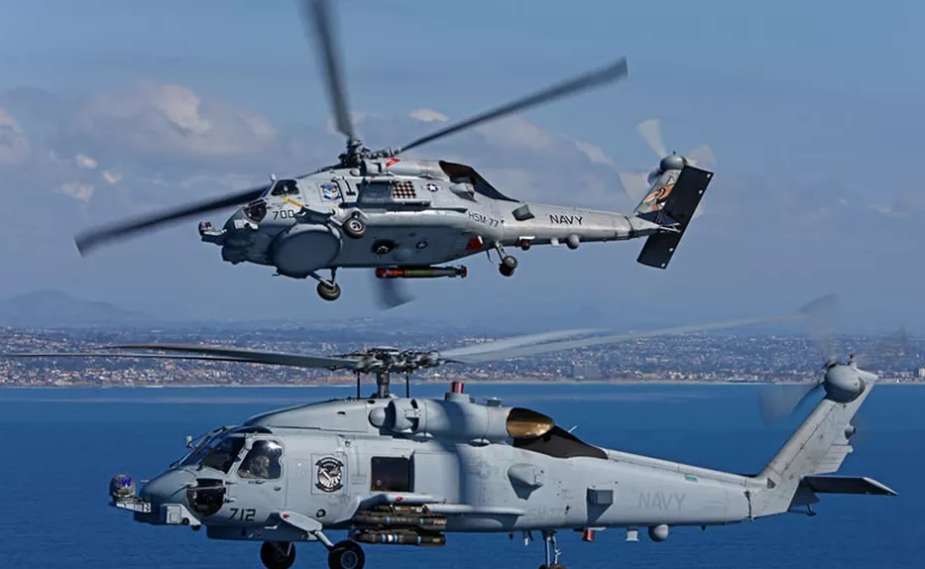Breaking news
Spanish Navy to receive 8 Sikorsky MH-60R Seahawk helicopters from US.
On October 12, the U.S. Department of Defense announced that Lockheed Martin was awarded a $379,577,128 firm-fixed-price order against a previously issued basic ordering agreement. This order provides for the production and delivery of eight Sikorsky MH-60R helicopters for the government of Spain. Work will be performed in Owego, New York (52%); Stratford, Connecticut (40%); and Troy, Alabama (8%), and is expected to be completed in March 2027. Foreign Military Sales customer funds in the amount of $379,577,128 will be obligated at the time of award, none of which will expire at the end of the current fiscal year. Naval Air Systems Command, Patuxent River, Maryland, is the contracting activity.
Follow Navy Recognition on Google News at this link
 Sikorsky MH-60R Seahawk (Picture source: Lockheed Martin)
Sikorsky MH-60R Seahawk (Picture source: Lockheed Martin)
The Armada (Spanish Navy) retired the last of 18 Sikorsky SH-3 Sea King helicopters in 2022 following deliveries that began in 1966. From 1988 to 2001, the Armada acquired 12 SH-60B aircraft, and more recently, purchased eight SH-60F Seahawk helicopters retired by the U.S. Navy. “The new MH-60R will upgrade mission systems and sensors of the SH-60B fleet, elevating the Armada to the highest level of anti-submarine and anti-surface warfare capability,” said the Armada. ”We expect a smooth transition from the SH-60B to the MH-60R.”
Spain’s eight new MH-60R aircraft will join a fleet of 330 worldwide operational with the U.S. Navy, Australia, Denmark, Saudi Arabia and India. Aircraft deliveries to Greece and South Korea will begin in 2024. In May, the U.S. Navy announced the global MH-60R fleet had surpassed 1 million flight hours.
“Spain’s confidence in the MH-60R is an attestation to our shared commitment to national security and the security of our allied nations,” said Capt. William Hargreaves, U.S. Navy H-60 Multi-mission Helicopters program manager. “We are committed to supporting Spain throughout this process from contract award through delivery while further solidifying our global partnership. The increased capabilities and new technologies of the MH-60R Seahawk will allow the Spanish Navy to remain a ready, capable and equipped fleet.”
Sikorsky MH-60R Seahawk
The Sikorsky SH-60/MH-60 Seahawk (or Sea Hawk) is a twin turboshaft engine, multi-mission naval helicopter based on U.S. Army's UH-60 Black Hawk and a member of the Sikorsky S-70 family. The most significant modifications are the folding main rotor blades and a hinged tail to reduce its footprint aboard ships. Able to deploy aboard any air-capable frigate, destroyer, cruiser, fast combat support ship, expeditionary transfer dock, amphibious assault ship, littoral combat ship or aircraft carrier, the Seahawk can handle anti-submarine warfare (ASW), anti-surface warfare (ASUW), naval special warfare (NSW) insertion, search and rescue (SAR), combat search and rescue (CSAR), vertical replenishment (VERTREP), and medical evacuation (MEDEVAC).
The MH-60R was originally known as "LAMPS Mark III Block II Upgrade" when development began in 1993 with Lockheed Martin (formerly IBM/Loral). Two SH-60Bs were converted by Sikorsky, the first of which made its maiden flight on 22 December 1999. Designated YSH-60R, they were delivered to NAS Patuxent River in 2001 for flight testing. The production variant was redesignated MH-60R to match its multi-mission capability. The MH-60R was formally deployed by the US Navy in 2006.
The MH-60R is designed to combine the features of the SH-60B and SH-60F. Its avionics includes dual controls and instead of the complex array of dials and gauges in Bravo and Foxtrot aircraft, 4 fully integrated 8" x 10" night vision goggle-compatible and sunlight-readable color multi-function displays, all part of glass cockpit produced by Owego Helo Systems division of Lockheed Martin. Onboard sensors include: AAR-47 Missile Approach Warning System by ATK, Raytheon AAS-44 electro-optical system that integrates FLIR and laser rangefinder, ALE-39 decoy dispenser and ALQ-144 infrared jammer by BAE Systems, ALQ-210 electronic support measures system by Lockheed Martin, APS-147 multi-mode radar/IFF interrogator, which during a mid-life technology insertion project is subsequently replaced by APS-153 Multi-Mode Radar with Automatic Radar Periscope Detection and Discrimination (ARPDD) capability, and both radars were developed by Telephonics, a more advanced AN/AQS-22 advanced airborne low-frequency sonar (ALFS) jointly developed by Raytheon & Thales, ARC-210 voice radio by Rockwell Collins, an advanced airborne fleet data link SRQ-4 Hawklink with radio terminal set ARQ-59 radio terminal, both by L3Harris, and LN-100G dual-embedded global positioning system and inertial navigation system by Northrop Grumman Litton division. Beginning in 2020, CAE's MAD-XR has been fielded on MH-60Rs, providing it with a magnetic anomaly detector.


























